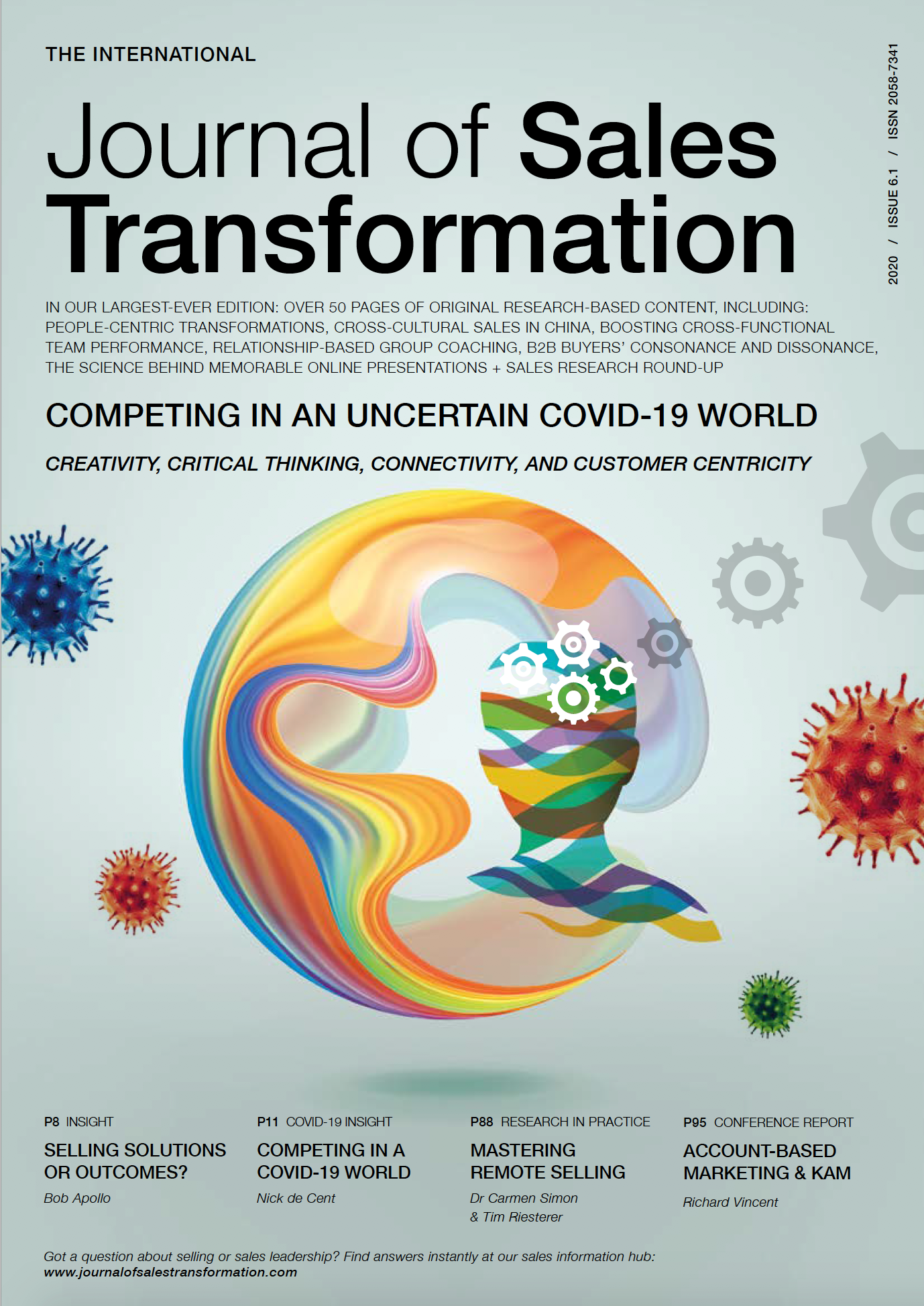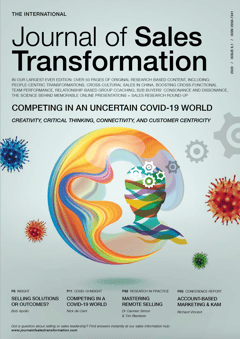Should we be selling 'solutions' or outcomes?
May 19, 2020

 Many sales methodologies - in the interest, no doubt, of selling more books and training courses - claim to have a uniquely effective approach. Yet, and perhaps inevitably, each methodology has its strengths, weaknesses and blind spots. None of them can credibly claim that they offer a universal “one best way”.
Many sales methodologies - in the interest, no doubt, of selling more books and training courses - claim to have a uniquely effective approach. Yet, and perhaps inevitably, each methodology has its strengths, weaknesses and blind spots. None of them can credibly claim that they offer a universal “one best way”.
Of course, it’s almost always the case that adopting a relevant methodology is better than not having a process at all. But choosing to only ever drink one brand of kool-aid is rarely a healthy long-term strategy. Some of the most effective sales leaders I have worked with have taken elements of the different methodologies and combined them together to create a pragmatic framework that works for their environment.
They might, for example, choose to combine an awareness of the SPIN question types with some of the Sandler conversational techniques and - where appropriate - applying Challenger tactics to introduce new perspectives to the customer. They could also incorporate Miller-Heiman’s approach to stakeholder assessment and use one of a number of opportunity qualification frameworks.
If chosen and implemented thoughtfully, pragmatically combining appropriate elements from different methodologies delivers better results than any one methodology could achieve on its own. One of the reasons why such combinations can work in practice is that almost all of the methodologies are based on a common foundational principle: using a consultative approach to identify and sell solutions to customer problems...
The problem with “solutions”
In fact, some observers lump all these methodologies together under the generic “solution selling” label. But there are a couple of problems with this focus on “solutions”. The first and most obvious one is that the only entity that is actually entitled to call anything a solution is the organisation that was suffering from the problem in the first place, and then only after the problem has been proved to have been resolved.
The second related problem is that almost all sales methodologies regard a sale as complete once an order has been booked. But if we look at the exercise from the customer’s perspective, it should be obvious that their search for a solution (whether you call it a “buying journey” or a “decision journey”) is only over once its implementation has been completed and the expected results have been achieved.
Yet when we visit many supplier websites and review their marketing messages, the word “solution” is typically plastered all over the place, often without any connection to the specific underlying problems or opportunities that the vendor’s products and services might have been intended to address.
And while the sales profession has been focusing on its ability to offer “solutions”, our prospective customer’s world has been undergoing profound change, which the current covid-19 crisis can only accelerate:
- The average size of the customer’s buying decision group continues to grow (to a current average of 10 or more in a complex purchase), making consensus harder to achieve and making it more likely the customer will decide to do nothing
- Vendors are increasingly delivering their offerings “as a service” rather than as a one-off purchase, meaning customers can and will choose to cancel them if they are not achieving the expected results
- Around 70% of all change programmes fail to deliver on the expected outcomes, often costing more, taking longer, missing critical functionality or having to be reduced in scope or abandoned
Confidence in outcomes
According to Gartner, decision confidence - or more accurately the lack of it - is now the primary factor in explaining why customers decide not to go ahead with projects that require a change in established methods or are associated with significant risk. I’d go further and suggest that what’s so often missing in the case of the unsuccessful pursuit of an apparent sales opportunity is the customer’s confidence that their desired outcomes will be achieved.
With all this going on around us, surely the sales profession should be promoting confidence in outcomes, and not just selling “solutions”. And surely, we should recognise that our customer’s decision journey isn’t over until and unless they conclude - with our help - that they have actually achieved those desired outcomes.
This has a number of important consequences, not least of which being the idea that sales, implementation and customer success need to be joined at the hip. It means that salespeople should not regard an opportunity as fully qualified until and unless the customer has acknowledged the outcomes they are seeking to achieve.
Uncovering and qualifying “needs” is only a part of the picture. Needs alone can’t tell us how the customer will measure the success of the project. They can’t tell us the relative priority of the project. And even if we believe we can satisfy these needs, they can’t tell us whether the customer is likely to implement our proposal.
Establishing desired outcomes
Focusing on understanding our customer’s desired outcomes has some profound implications for the sales process. It highlights the critical importance of our discovery and diagnosis process. It requires that we understand our customer’s current situation, their goals and desired outcomes, the impact of failing to achieve them, and the obstacles that are standing in their way.
It requires that we recognise that if the perceived gap between our customer’s current situation and desired outcomes is small and stable, they are likely to stick with the status quo, but if that gap is large and growing, they are far more likely to accept the need for urgent change.
It requires that we identify what other credible options the customer might be considering (not just our obvious competitors), and that we position our approach to achieving their desired outcomes as being credible, well-proven, distinctively different and capable of delivering unique benefits.
It requires that we collaborate with our key sponsor to create a credible and realistic internal business case that is compelling enough to get approved but not so optimistic that it will probably never be achieved, and that we provide the evidence and proof points necessary to give them confidence in both their decision to choose us and in the expected outcomes.
Mutual success plan
Our collaboration with both the customer and our colleagues in implementation and customer success is best reflected in a mutual success plan that works backwards from the date by which the desired customer outcomes need to be achieved and establishes the key milestones and success criteria along the way, whilst clearly allocating key aspects of ownership.
Having a mutual success plan can help to support our sales and implementation process, the customer’s decision-making process and the achievement of the mutually agreed outcomes upon which the success of the whole project will depend. It can help to ensure that our implementation and customer success teams clearly understand why the customer bought from us and what they expect from us.
And by paying close attention to the achievement of our customer’s desired outcomes, we can ensure we are at all times aware of the value we are delivering to them and can increase our chances of renewing and expanding our relationship with them.
A matter of perspective
At the end of the day, it’s a matter of perspective. Many elements of many established sales methodologies remain relevant. But they will be even more effective if we start with the end in mind - our customer’s desired outcomes.
If you'd like to learn more about implementing an outcome-centric approach in your B2B sales organisation, you might like to start by downloading our guide. And when you're ready, let's find a time to talk.
This article was first published in the May 2020 issue of the International Journal of Sales Transformation and is reproduced with permission. You can get a year's subscription free for the journal using code ijost20 when you checkout.
ABOUT THE AUTHOR
 Bob Apollo is a Fellow of the Association of Professional Sales, a founding contributor to the International Journal of Sales Transformation, an active member of the Sales Experts Channel and the Sales Enablement Society, and the driving force behind Inflexion-Point Strategy Partners, the leading proponents of outcome-centric selling.
Bob Apollo is a Fellow of the Association of Professional Sales, a founding contributor to the International Journal of Sales Transformation, an active member of the Sales Experts Channel and the Sales Enablement Society, and the driving force behind Inflexion-Point Strategy Partners, the leading proponents of outcome-centric selling.
Following a successful corporate career spanning start-ups, scale-ups and market leaders, Bob now works as a strategic advisor, mentor, trainer and coach to ambitious B2B sales organisations - teaching them how to differentiate themselves through their provably superior approach to achieving their customer's desired outcomes.


Comments